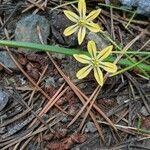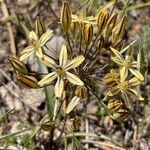Leaves 1–2, 10–50 cm × 3–15 mm; blade linear. Scape 10–80 cm, usually smooth, sometimes scabrous near base. Flowers: perianth straw-colored or golden yellow, or sometimes white flushed with purple, usually similarly colored both adaxially and abaxially, 12–27 mm, tube acute at base, 3–10 mm, much shorter than or equal to lobes, lobes ascending to reflexed, with green, brown, or purple midveins, 6–20 mm; stamens attached at 1 level, held close to pistil, unequal, alternately long and short; filaments dilated entire length, noticeably flattened, apical appendages present, forked, those of longer filaments pointed, conspicuous; anthers white, cream, yellow, or blue, 1–2 mm; ovary longer than stipe; pedicel 1–9 cm (–12 cm in subsp. cookii). 2n = 10, 14, 16, 24, 32, 40, 42, 50.
More
An onion family plant. It is a corm or bulb plant. It re-grows from the bulb after a dormant period. It grows 45-60 cm high and spreads 20-30 cm wide. The leaves are grass-like. The flowers stems are wiry. They have heads of about 10 golden yellow flowers. These are widely flared and funnel shaped.
It is a temperate plant. They need moist, well-drained soils. The soils should never be waterlogged. It needs an open, sunny position. It is resistant to frost. It suits hardiness zones 7-10.
More
Coniferous forests; deciduous forests; foothill woodlands; stream sides; wet ravines on serpentine; valley grasslands, at elevations from sea level to 3,000 metres.


